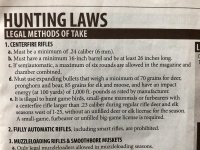Colorado's big game laws are designed to provide as ethical a kill as possible, hence the required 1000 ft lbs energy at 100 yards. There is no doubt that an original 44-40 load would kill a mule deer or even an elk, but how far did you have to follow the blood trail and how many got lost in the process? My quick check of ballistics showed that the cartridge has only about half the required energy at 100 yds.
And, yet, handguns, with a a minimum 4" barrel, using at least a 6mm bullet, generating a minimum 550 ft lbs. at 50 yards ARE allowed. I'm not sure I understand the thinking. Its not OK to use a "weak" rifle but a handgun, making less than 1/2 the energy of the rifle is allowed?!? I guess most guys carrying a sidearm, do so for a backup.
Anyone hunting big game with a handgun, or bow, for that matter, would still have some ethical/sportsman's issues to deal with, I would think.
As far as arrows causing death by exsanguination, versus a bullet killing by shock...isn't a double lung shot from a rifle meant to do most of its damage by exsanguination?
just curious, as I've done a bit of hunting, but never really examined the terminal ballistics of it all.
I stopped bow-hunting years ago, because, for me, it doesn't seem like a humane way to kill a noble animal, unless you're William Tell, with arrow placement. I never was.

